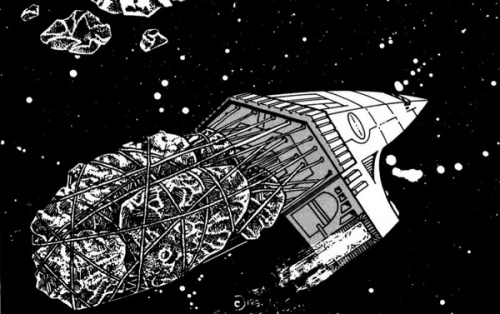Brown class Jump Ship
| Brown class Jump Ship | |
|---|---|
 Bridge of the Brown class Jump Ship | |
| Type: RV Freighter | |
| Category | BCS |
| Size | 5,000 Tons |
| Hull Configuration | Cone Hull |
| Streamlining | Streamlined Hull |
| Tech Level | TL–15 |
| Engineering | |
| Computer | Model/6 |
| Jump | J-6 |
| Maneuver | 1 G |
| Armaments | |
| Hardpoints | 0 |
| Accommodations | |
| Staterooms | 20 |
| Personnel | |
| Crew | 38 |
| High/Mid Passengers | 0 |
| Payload | |
| Cargo | 140 Tons |
| Fuel tank | 3,300 Tons |
| Construction | |
| Construction Time | 33 Months |
| Origin | Third Imperium |
| Price | |
| Cost | MCr3,337.4 |
| Statistics | |
| Quick Ship Profile | R-05P16 |
| Universal Ship Profile | R-E261662-000000-00000-0 |
| Images | |
| Blueprint | No |
| Illustration | Yes |
| Source | |
| Canon | Published, canon design |
| Designer | Timothy Brown |
| Design System | High Guard |
| Era | 1105 |
| Reference | Fighting Ships 22-23. |
The Brown class Jump Ship is a TL–15 Jump ship freighter. This ship is also known as the Type TJ class jump ship. Due to the manner of attaching the pods, these types of ships are also known as Jump Trains.
Description[edit]
The Brown class Jump Ship is designed to provide maximum flexibility in interstellar transportation. As built, it is capable of Jump-6 and 1-G. Special field cables attached to the rear of the ship extend the ship's jump field to include this additional cargo. Alterations in displacement will affect the size of the jump itself, but the amount of cargo carried can be varied to fit the needs. [1]
Capabilities: For each 1,000 tons of cargo carried in the mesh cables behind the ship, jump is decreased by one. Thus, if the 5,000-ton ship carries 1,000 tons behind it, it can only perform Jump-5. If it carries 5,000 tons behind it, it can only perform Jump-1. In all cases, the internal fuel tankage of the ship (3,300 tons) is sufficient to support the jump.
Jump Pods: The jump ship can transport valuable raw ores, planetoid chunks, and other materials directly in its jump mesh. Only durable goods can be carried in this manner because they are exposed directly to the vacuum of space. To allow the transport of other materials, jump pods have been constructed on a variety of designs. Typically, each displaces 1,000 tons and can function independently of the jump ship.
Some basic designs for jump pods include the following:
- Cargo Pod: A bulk cargo carrier displacing 1,000 tons and carrying approximately 950.0 tons of cargo. Several varieties are available, including special liquid tankers, bulk food, or grain carriers, and compartmented transport containers. MCr100.
- Passenger Pod: A large pressurized hull with 225 staterooms, plus recreational facilities, safety compartmentalization, and fittings for comfort. MCr212.5.
- Low Pod: Similar to a passenger pod, the low pod is fitted with 1,900 low berths for carrying people or animals long distances. MCr195.
- Other Pods: Additional types of pods are possible, and have probably been produced somewhere in the Third Imperium.
Image Repository[edit]
- A Type TJ class Jump Ship hauling valuable asteroid ore with its flexible jump net.
Basic Ship Characteristics[edit]
Following the Imperial Navy and IISS Universal Ship Profile and data, additional information is presented in the format shown here. The small craft factor indicates the number of squadrons (...of ten subcraft) carried on the ship. Tonnage on the universal ship profile is shown in kilotons (...thousands of tons) where necessary. [2]
| Basic Ship Characteristics [3] | ||
|---|---|---|
| No. | Category | Remarks |
| 1. | Tonnage / Hull | The Brown class is constructed using a 5,000 Ton hull built in a generally wedge-shaped configuration. The hull qualifies as partially streamlined, giving a relatively limited atmospheric performance that is reliant on its onboard gravitic systems.
|
| 2. | Crew | Total Crew Complement: x38
Accommodations
Accessible areas of the hull are fitted with grav plates and inertial compensators and have full life support and environmental systems.
|
| 3. | Performance / Engineering | The vessel mounts a Jump-6 drive, a Maneuver-1 drive, and a Power Plant-6, giving a maximum performance of Jump-6 and 1G acceleration and producing 300 Energy Points. The ship has an agility rating of 1. The internal fuel tankage is sufficient for one Jump-6 and gives the power plant 4 weeks duration.
|
| 4. | Main Section / Electronics | Adjacent to the bridge is a Model/6 Computer: the ship is not fitted with a backup ship computer.
|
| 5. | Hardpoints | x50 hardpoints. |
| 6. | Armament / Weaponry | The vessel is unarmed. |
| 7. | Defenses | The hull is unarmored.
The vessel is not fitted with screens or other passive defensive systems. |
| 8. | Craft / Drones | The vessel carries no subcraft. |
| 9. | Fuel Treatment | The vessel has internal fuel tankage of 3,300 Tons.
|
| 10. | Cost | The basic cost of the vessel is MCr3,337.400 |
| 11. | Construction Time | 144 weeks (36 months) as standard.
|
| 12. | Comments | Standard cargo capacity amounts to 140 dTons.
|
History & Background[edit]
Some have noted that a jump pod happens to be the same cargo tonnage of the much older Ghost Galleon class Cargo Ship design, which design sometimes carries pods in exactly the same way. While it is easy to imagine that the Brown class evolved from the Ghost Galleon, just up-sized to carry 6 pods and with better performance, there is no evidence to conclusively prove that this is what happened. [5]
Class Naming Practice/s & Peculiarities[edit]
Jump Ships tend to be named in a number of fashions. Some are named after famous gentlesophonts of distinction and enduring service, others after the minerals, gems, and precious substances that they are often used to mine by belters.
In the case of the Brown class Jump Ship, it was naval by famous naval engineer T.B. Brown, a distinguished gentlesophont who designed dozens of popularly used starships, warships, and smallcraft. In connection with Brown's designs and work towards the Jump Train concept, modular technology has grown quite popular within Imperial Space and within the larger area of Charted Space, and his actions as a naval engineer reflect well upon him and the Imperial Navy, as well as the many megacorporations and corporations he later worked for. [6]
Selected Variant Types & Classes[edit]
29 Representative Freighter (RV) Classes[edit]
A
B
C
D
E
G
H
I
K
L
M
N
O
P
R
S
References[edit]
| This article has metadata. |

|
This ship was originally designed using one of the Classic Traveller ship design rules:
|
| The ship, vehicle, equipment, or other technology in this article wasn't given a specific, distinctive name upon first publication. FFE has given the wiki permission to name this generic setting detail in order to better catalogue it. Names are chosen a wiki administrator based on personal preferences.
You can help the Traveller RPG Wiki by letting the wiki administrators know if the item has a name that wasn't published, was omitted accidentally from publication, that you are familiar with, or might have been popularly known within the greater Traveller community. |
- Timothy B. Brown. Fighting Ships (Game Designers Workshop, 1981), 22-23. (Classic Traveller Supplement 9)
- ↑ Timothy B. Brown. Fighting Ships (Game Designers Workshop, 1981), 22.
- ↑ Timothy B. Brown. Fighting Ships (Game Designers Workshop, 1981), 10.
- ↑ Timothy B. Brown. Fighting Ships (Game Designers Workshop, 1981), 10.
- ↑ Information provided to the library by Ade Stewart
- ↑ Information provided to the library by Adrian Tymes
- ↑ Information provided to the library by Maksim-Smelchak
